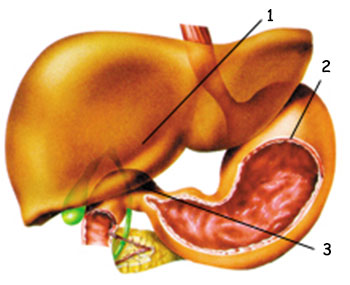 |
1. Liver |
Cross-section of the stomach |
Every phase of the stomach’s very detailed creation is directed towards a particular end. Food enters the stomach through a narrow entrance known as the cardia. The muscles in this gap joining the esophagus to the stomach function as a kind of valve, preventing half-digested food from returning to the esophagus. Food then moves to the spherically-shaped top of the stomach and mixes with the stomach acid there, before taking a sudden turn to enter the stomach’s widest part, known as the body.
In this area, which is shorter than the upright part above it, the stomach narrows once again and opens onto the 12 finger intestine through a passage known as the pylorus, or stomach gatekeeper. This passage at the bottom of the stomach also serves as a kind of valve, ensuring that semi-digested food leaves the stomach and moves on to the intestines. The rhythmic wave motion of the powerful stomach muscles, sited in three layers, ensures that food moves correctly from the mouth of the stomach to the pylorus. At the same time, this wave motion helps rinse the food, grinds it into smaller particles and eventually turns it into the semi-liquid mixture known as chyme. The necessity of these detailed processes will become clear in the later stages of the digestive process.
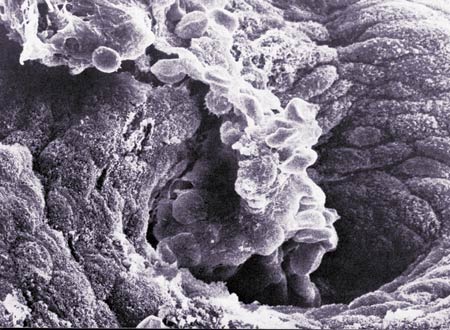 |
Mucus secretion protects the stomach from acids. |
The digestive system in the stomach is very different from that in the mouth. As soon as food descends from the esophagus, cells on the stomach’s inner surface begin secreting a powerful substance known as gastric acid. Together with this substance, fluids known as pepsin and hydrochloric acid (or HCl) are also secreted, powerful enough to be able to dissolve a razor blade. But their presence is essential if such hard-to-digest substances as protein are to be assimilated. But the stomach itself consists of proteins. How is it that this powerful acid does not damage the stomach itself?
This is one of the countless examples of the creation in the human body. The stomach does not actually digest itself, because there are cells within the deep troughs in the stomach’s rough wall that possess very different properties. Maintaining a very delicate balance, some cells in the stomach secrete HCl acid, while others next to them give off a sticky fluid known as mucus, which lines the stomach wall and shields it from the acid, preventing acids and enzymes from harming the stomach’s cells. Mucus also prevents ingested viruses and other micro-organisms—which cause infections—from entering the cells, and also lubricates the passage of food through the alimentary canal.
But how do all these processes take place? How does this protective environment form within the stomach? Could the stomach cells decide on their own to produce these substances, or discovered or learned the formula for this protective mucus coating?
For cells to be able to do such a thing and for the production of the necessary substances for digestion, a number of cells must first become aware that food needs to be digested. Those same cells must also know that a substance like acid is needed for digestion to occur. Then those cells must discover the formula for HCl, the most suitable acid, and begin producing it. At the same time, for the production of the protective coating, various other cells need to establish that this acid—so powerful that one drop of it can burn a hole in a carpet—could harm them and then analyze the acid and develop a formula to neutralize it. Any error in that formula would doom the stomach to being dissolved by its own acid.
1. Inclined layer of muscle layer 3. Serosa 5. Lamina propria of mucosa muscle layer 7. Muscle layer 10. Epithelium | 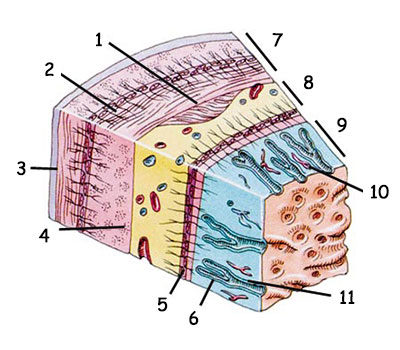 |
To the side is shown a cross-section of the stomach wall. Cells in the stomach wall, which is made up of several layers, all have different functions. Such a detailed creation could obviously never have come into being by chance. It is Allah, the Omnisicent, Who creates the stomach. | |
Of course, the emergence of mutually complementary substances in the stomach is by no means as simple as this summary may suggest. The determination of the formulae alone is a major phenomenon, and it’s quite impossible for any cell to arrive at a chemical formula and then use it to generate a substance. A cell consisting of unconscious atoms does not possess the necessary intellectual capability.
Even if we transgressed the bounds of logic and assumed that human stomach acid did actually come into existence this way, still we could not expect the complementary protective substance to emerge over the course of time. It is out of the question for acids strong enough to dissolve razor to remain for as long as the 2 to 3 days they would take to destroy the stomach itself, let alone for millions of years.
Bearing all this in mind, we are confronted by one evident truth. The co-existence of hydrochloric acid, together with the mucus that protects the stomach from it, is one of the countless instances of the order in Allah’s creation. Allah has created the human body as a whole, using a flawless creation.
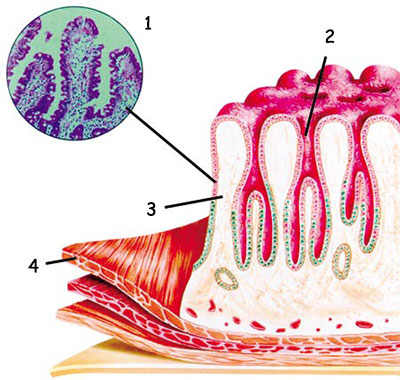 | 1. Micro-image of villum 2. On the surface of every villum, there are minute wings known as microvilli. 3. Folded structures on the stomach surface provide a huge area for food digestion. 4. Muscle |
| On the stomach’s interior surface, there are curved structures known as villi, whose creation facilitates food digestion. |
This is by no means the only example of planning in the way the stomach works. As you have seen, the system in the human body is so perfect that precautions have been taken, right from the outset, to meet every possible eventuality. For example, the presence of digestive acids in an empty stomach, no matter how much the mucus protects it, will shortly have a damaging effect. That is why no digestive acid is secreted when the stomach is empty, thus removing any danger. Present in the empty stomach is an enzyme called pepsinogen, which has no digestive properties. When food arrives in the stomach, however, the stomach cells begin secreting their HCl, which immediately alters the structure of the pepsinogen in the empty stomach, turning it into the very powerful fragmentation enzyme pepsin. This immediately breaks down the foods in the stomach. 30
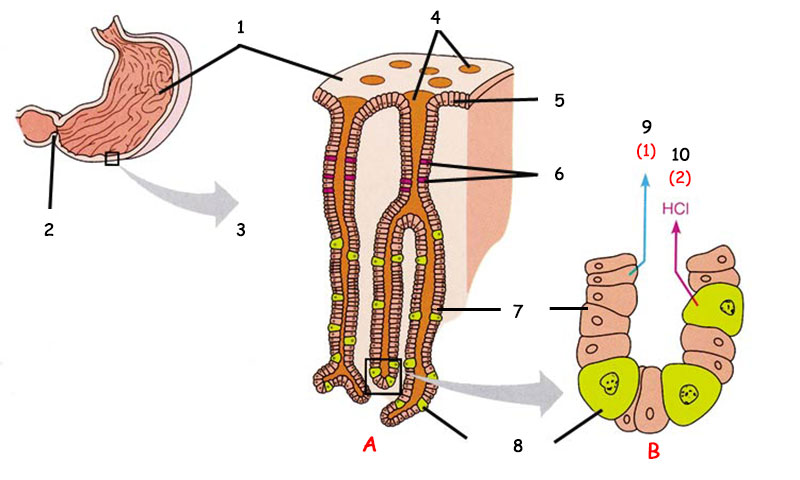 | |
1. Inner surface of stomach | 6. Muscle link around the pylorus |
Shown above is the anatomy of the stomach. | |
A little thought will show that any liquid that is harmless as long as the stomach is empty but turns into a powerful fragmenter when the stomach fills could not have emerged by means of unconscious coincidences. It is absolutely impossible for one substance to turn into another by chance, especially by adopting the correct formula on each occasion—let alone for this process to take place in human beings before every meal. This leaves the possibility of chance entirely out of the question.
Clearly, some force knows when the stomach cells are to secrete which substance, permits the cells to act appropriately, and regulates the timing of HCl acid secretion. This force that reigns in the human body is Allah, the Creator of the entire universe, all the living things in the universe, and human beings.
After eating, you experience a feeling of fullness, even of heaviness. But apart from that, you may well be unaware of the considerable activity that’s happening in your stomach. Your stomach constantly twists from right to left and up and down, in the effort to digest food better. Thanks to your stomach’s special suspension system, however, you remain unaware of these movements.
The stomach muscles are arranged in three separate directions. This allows the stomach to move easily from right to left, up and down, and diagonally, permitting food to make better contact with the stomach fluids. However, movements of this kind always bring with them a drawback: friction.
The stomach is located next to the intestines. Its constant movement means that it rubs against the intestines, which could give rise to serious health problems.
A precaution against this danger has been taken, of course. The stomach’s outermost surface is covered with a membrane called the peritoneum, which secretes a slippery liquid that lubricates the stomach and intestines externally, thus preventing these organs from abrading each other and being damaged by friction. 31
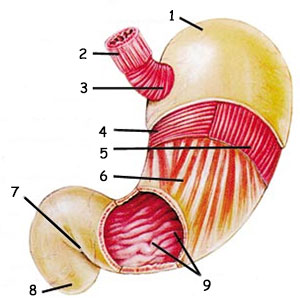 |
1. Stomach membrane |
The layers of stomach muscles are arranged in three separate directions. Thanks to this structure the stomach is easily able to move up and down, left and right, and diagonally. This special creation of Allah allows food in the stomach to be ground down more easily. |
One unexpected feature of the stomach mucus is that it contributes to the structure of the blood. Stomach mucus does not itself produce blood, but it does, however, contribute important assistance to bone marrow, which produces red blood cells. It permits Vitamin B12, which is of great importance to the body, to reach the bone marrow. When you examine the journey undertaken by Vitamin B12 en route to the bone marrow, and the role of stomach mucus in that journey, a great miracle appears on the microscopic level.
After entering the human body, Vitamin B12 travels along the digestive system and subsequently passes from the small intestine to the bloodstream, and finally reaches the bone marrow.
The assimilation of Vitamin B12 starts in the small intestine. However, no digestive cell in the small intestine is capable of adhering to Vitamin B12. However, in one small region of the small intestine is a group of cells whose sole function is to do this.32 These cells devote their whole lives, in a miraculous manner, to trapping Vitamin B12. These cells are able to distinguish and seize Vitamin B12 from among trillions of other molecules.
Consider the miracle that is taking place: The cells that trap the Vitamin B12 must know its importance for the human body. They have been specially located in a specific part of the small intestine, in order to fulfill that function. Although they devote their lives to catching Vitamin B12, the vitamin is actually of no benefit to them. Having caught the vitamin, they release it back into the bloodstream and send it somewhere else of which they are unaware.
The motive displayed by these cells as they trap this vitamin cannot, of course, have come into being by chance. Clearly this system has been specially created. When you examine the system in a little more detail, still more astonishing miracles appear.
The cells in the small intestine are unable to recognize Vitamin B12 in its raw state. In order for these cells to identify and trap Vitamin B12 molecules, they need to be indicated by another special molecule. This requirement has of course been considered, and a system has been installed allowing Vitamin B12 to be “marked” before reaching the small intestine.
While the Vitamin B12 is still in the stomach, the cells produce a special molecule for it in the form of an ID card that the Vitamin B12 molecule will need on the following stages of its journey. This identity card sticks tightly to the Vitamin B12 as it continues on its way, eventually arriving at the small intestine.
As you have seen, a small group of cells in the small intestine, responsible solely for finding Vitamin B12, will allow it to travel through the bloodstream. Yet these cells will be unable to recognize Vitamin B12 in its natural state, which is when the identity card comes to the vitamin’s assistance. Thanks to this ID card, the nerve cells recognize Vitamin B12 from among trillions of molecules. Subsequently, they permit the Vitamin B12 to enter the bloodstream. In this way the B12 reaches the bone marrow through the blood.
As you see, the stomach cells know the importance of Vitamin B12 for the human body. Moreover, these cells know that cells in the intestine will need a special marker to recognize Vitamin B12, and duly produce that identifying molecule. Then the intestine cells—devoid of eyes, hands or brain—recognize this marker and trap the Vitamin B12.
Don’t forget, the Vitamin B12 assimilated as a result of all these events is of no use to cells in either the stomach or the intestine. This vitamin is used far distant, in the bone marrow, thanks to which, red blood cells can be produced in the body, and human life is able to continue.
Just the details of journey undertaken by this vitamin are sufficient to demonstrate the perfection of the systems within the human body.
No doubt, the consciousness and flawless functioning exhibited during these processes cannot be performed by the cells in question. When all is said and done, cells are only structures formed by assemblages of unconscious molecules. It is utterly meaningless to search in the cell for consciousness, free will or power. The evident truth is that the stomach cells, together with the mechanisms that give rise to blood production, were created by the same creator—Allah—and that they fulfill their functions through His inspiration.
Allah, there is no deity but Him, the Living, the Self-Sustaining. He is not subject to drowsiness or sleep. Everything in the heavens and the Earth belongs to Him. Who can intercede with Him except by His permission? He knows what is before them and what is behind them but they cannot grasp any of His knowledge save what He wills. His Footstool encompasses the heavens and the Earth and their preservation does not tire Him. He is the Most High, the Magnificent. (Surat al-Baqara: 255)
Food in the stomach, now turned into a gelatinous paste, is forwarded from the duodenum through a one-way valve to the small intestine, an organ only 3 centimeters (1.18 inches) in diameter but more than 7 meters (23 feet) long. This 7-meter (23-foot) tube has been folded, squeezed and packaged into the abdomen of every human being. The miracle is not limited to this packaging, however. Vital phenomena take place inside this narrow enclosure.
Although a large part of the food is broken down in the stomach, some of it remains in the stomach, not broken down into its smallest components. These still-undigested foods that leave the stomach also reach the small intestine shortly afterwards. For example, fats are hard to digest, being very large molecules and indissoluble in water. For that reason, fat digestion occurs not in the stomach, but in the small intestine.
At this point, the pancreas and the liver go into action. These two organs send a special fluid into the small intestine, with the help of a channel or duct.
The liver is apparently aware that the stomach cannot break down fats. At the same time, it possesses the chemical formula for a special compound. As soon as fatty foods reach the small intestine, the liver releases the liquid it has prepared and stored, at exactly the right time and place.
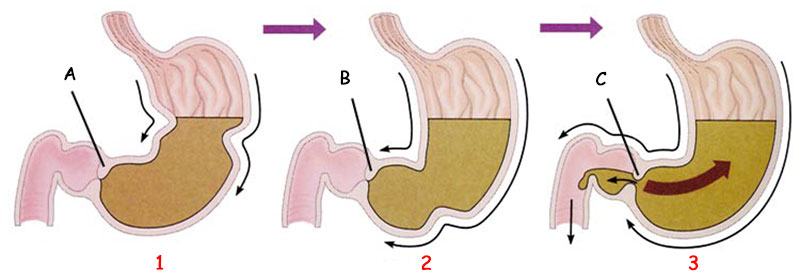 | ||
A. Closed stomach mouth (pylorus) | B. Closed pyloric valve | C. Pyloric valve slowly opens. |
Peristaltic motions (rhythmical muscular contractions) assist the mixing of nutrients inside the stomach and direct them toward the pyloric valve.. | ||
The function of this secretion, known as bile, is not limited to breaking down fats. It also helps with the absorption of fats broken down by the small intestine. In addition, it contains special chemical compounds that permit the intestines to absorb vitamins, and is also an antiseptic that kills harmful bacteria remaining in the intestine.
Gall subjects the fats in foodstuffs reaching the small intestine to a preliminary process that will increase the effect of the pancreatic secretion. The various enzymes contained in pancreatic fluid assist not only in the digestion of fats, but also of starch and proteins. There are also large numbers of glands in the mucosa covering the wall of the small intestine that secrete various enzymes that play an important role in the digestion of foods sufficiently broken down. Most of the food in the small intestine gets broken down some 3 to 5 hours after eating. In this way, carbohydrates are reduced to simple sugars, proteins into amino acids, and fats into glycerol and fatty acids, ready for assimilation. The cells in the small intestine absorb these molecules and then release these nutrients into the bloodstream.
When the foodstuff is ready to leave the small intestine, no nutrients remain apart from water and certain vitamins.
Cells That Produce an Electric Current |
Various mechanisms permit the foods to be transmitted along the digestive tract. One is the involuntary contraction of the muscles in the intestines. Thanks to the rhythmic contraction of these muscles, foodstuffs always progress in one direction only. But why? A team of researchers led by Jan Huizinga of McMaster University in Canada investigated this subject, examining the cells that bring about this one-way movement. They used micro-electrodes located along the digestive tract to establish that the so-called interstitial cells of Cajal set up a constant, regular electrical current. This current permits the muscles, that surround the intestine wall, to contract constantly. However, the presence of an electrical current is not sufficient for this mechanism to function. The current must also be set up with a flawless rhythm. Within the intestines, therefore, the cells of Cajal set up a web that allows them to give off electrical impulses at the same rhythm. (Science et Vie, September, 1998). Thanks to this flawless mechanism, the things you eat remain in the digestive tract and are turned into a form your body can make use of. Were it not for the rhythmical electrical impulses established by the cells of Cajal, the muscles in your intestines would not contract in harmony, which could lead to the food you eat heading back into your throat instead of traveling onward. However, apart from in certain cases of sickness, we are never faced with this disagreeable phenomenon. As this example shows, the system created by Allah in the human body is flawless in every respect. Thanks to this blessing, we are all able to carry on with our lives. |
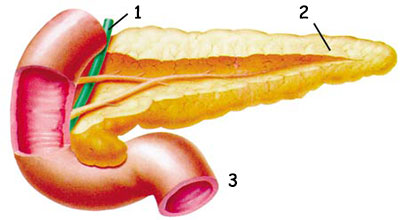 |
1. Choledoch duct |
Unlike the stomach, the duodenum has no special layer to protect it from acid. Under the special system created by Allah, however, the pancreas has been placed at the service of the duodenum. Bicarbonate molecules produced by the pancreas neutralize the stomach acids and thus protect the duodenum. |
As you have seen, digestion takes place by means of acids in the stomach. As a result, rather powerful acids remain in the paste reaching the intestines from the stomach, and they might represent a grave danger to the duodenum. Unlike the stomach, the duodenum has no special mucus layer to protect it.
Why, therefore, is the duodenum not damaged by this acid?
To find the answer to this question, we encounter astonishing digestive processes taking place within the body.
When the acid reaching the duodenum from the stomach reaches a dangerous level, cells on the duodenum’s wall start secreting a hormone called secretin. There are several aspects of this process. First, secretin exists in the intestinal walls in the form of pro-secretin. Under the effect of the digested food, this hormone turns into secretin, a separate substance that eliminates the harmful effects of the acidic secretions by stimulating the pancreas. 33
Like most other hormones, secretin reaches the pancreas by way of the bloodstream and calls on the pancreas for help in secreting enzymes. Realizing that the duodenum is endangered, the pancreas sends bicarbonate molecules to that region, neutralizing the stomach acid and protecting the duodenum.
How did these processes, so vital to human life, come about? Intestinal cells know that the substance they need can be found in the pancreas. They know how to eliminate the effects of stomach acid by disrupting its chemical formula. They know the substance’s formula by stimulating the pancreas, and the pancreas understands the message from the duodenum and starts enzyme secretion. All these are all matters worth considering.
In reference to the intestinal cells, such terms as “know” and “be aware” are used here to emphasize the miraculous aspect of the processes taking place in the body. Otherwise, as every rational person can realize, a cell can’t possibly think, possess free will and take decisions, be aware of another organ’s features, and to determine formulae.
The way that cells, with no brain or consciousness labor in the dark innards of the body is the result of Allah’s superior creation. It is Allah, with His matchless knowledge, Who creates cells and the characteristics they possess. Such features created by Allah in the human body reveal the limitless nature of His might.
1. Bile duct 8. Epithelium | 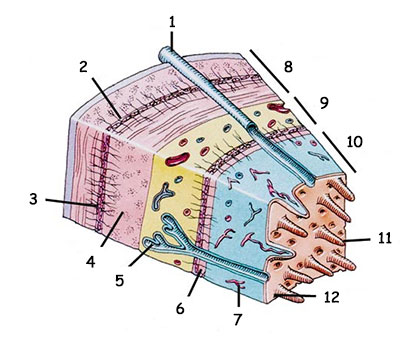 |
To the side, a cross-section of the duodenum wall. All the cells comprising the layers in this section play a role in the digestion of foods, as if they were all conscious entities. | |
The digestion of food is completed in the small intestine. But the final stage is the absorption of digestion’s products so they can be sent to where they’re needed in the body. Absorption in the mouth and stomach is minimal; absorption occurs wholly in the intestines, to which the structure of the small intestine is entirely suited.
The interior surface of the small intestine is very rough and wrinkled, with microscopic pumps on these wrinkles and protrusions. These pumps are actually absorber cells that trap nutrients the body needs and pump them out to the blood capillaries to which they are joined. These tiny pumps know exactly what our bodies need: broken-down sugar to be used in our brain cells, and amino acid to be used in our muscles. These minute pumps display reason in finding and trapping the nutrients we need. Even as you read these words, millions of these pumps are sending the necessary nutrients to the relevant locations that enable you to do so.
Thanks to the wrinkles and tiny pumps in the intestines, the small intestine in an adult actually occupies a rather large surface area—around 300 square meters (358 square yards), or the approximate equivalent of two tennis courts. 34
In this wide area, the absorption of nutrients takes place. Food is first broken down and turned into a paste, which is then spread out over the interior of the intestine in a thin layer, so that the cells can easily absorb all the nutrients in food.
Elements Participating in Digestion
| Group exposed to digestion | Site of digestion | Digested substance (impacting substance) | Digestive enzymes | Site of enzyme preparation | Situation affected by enzyme | Situation arising with digestion | If absorbed in the small intestine, product enters villum capillary vessels. |
| Carbohydrate Digestion | Mouth | Starch (cooked) | Amylase | Saliva glands | Dekstrin Maltose | Dekstrin Maltose |
|
Duodenum Small intestine | Starch | Amylase | Pancreas | Alkali | Maltose | ||
| Maltose | Maltose | Small intestine glands | Alkali | Glucose + Glucose | |||
| Saccharose | Saccharose | Glands in the small intestine | Alkali | Glucose + Fructose | |||
| Lactose | Lactose | Glands in the small intestine | Alkali | Glucose + Galactose | |||
| Protein Digestion | Stomach | Protein | Pepsin (in presence of HCl) | Stomach | Acid | Peptone polypeptide | Capillary blood vessels in the villum |
| Milk protein | Rennin | Stomach | Acid | Separation of casein | |||
| Duodenum | Peptone polypeptide | Trypsin | Pancreas | Alkali | Peptides (amino-acids) | ||
| Peptone polypeptide | Chymotrypsin | Pancreas | Alkali | Peptides (amino-acids) | |||
| Small intestine | Peptides (intermediate compounds such as tripeptide) | Erycin | Small intestine glands | Alkali | Amino acids | ||
| Fat Digestion | Duodenum Small intestine | Fat | Lipase | Pancreas | Alkali | Fatty acid glycerine (glycerol) | Capillary lymph vessels (lymph pipelines) in the villum |
| Nucleic Acid Digestion | Duodenum Small intestine | DNA and RNA | Deoxyribonucl ease and ribonuclease | Pancreas | Alkali | Nucleotide building blocks | Capillary blood vessels in the villum. |
| Hormone | Organ in Which It is Secreted | Stimulating Factor in Secretion Production | Reaction Organ | Reaction Organ’s Response |
| Gastrin | Stomach mucosa | Presence of food in stomach | Stomach mucosa | Gastric fluid |
| Secretin | Duodenal mucosa | Presence of acidic foods in duodenum | Pancreas | Initiates enzyme release |
| Enterogastrone | Small intestine mucosa | Fatty acids | Stomach | Deceleration of stomach activity |
| Cholesystokinin | Small intestine mucosa | Acidic foods | Gall bladder | Gall bladder causes production of gall. |
| Pancreozymin | Duodenal mucosa | Acidic foods | Pancreas | Slow down the working of the pancreas |
All the process during digestion depicted above are performed in a complete and ordered manner.
The digestive system’s flawless creation, which never gives rise to any confusion, belongs to Allah.
One of the small intestine’s special features is its ability to absorb just enough of certain needed substances. For example, too much iron can harm the body. Iron reaching the intestines above a particular level is excreted without being digested. Were this not to happen, the result would be serious illnesses.
In addition, as mentioned earlier, regions in a very special part of the small intestine are composed of cells prepared to absorb Vitamin B12. People who have this area of their intestines surgically removed must receive additional vitamin supplements, or they will die.
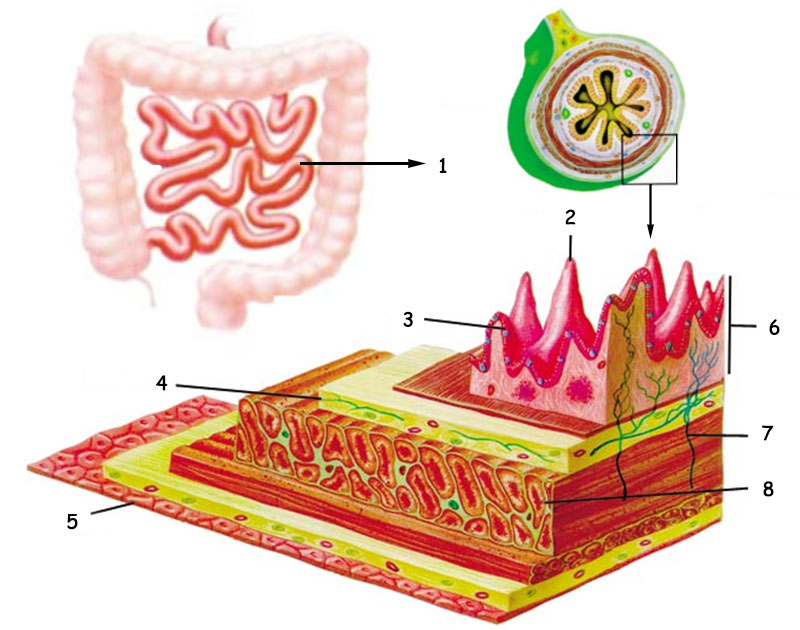 | |
1. Small intestine | 5. seroza |
The small intestine is an organ with very special functions. This organ’s cells are able to select useful substances by identifying which substance is which. | |
The selectivity of cells in the intestines needs consideration, to better comprehend the greatness of Allah. The intestines are in lightless area of human body, with neither the intelligence nor the information to distinguish between substances. Even so, they can distinguish beneficial substances from harmful ones, and expel unnecessary matter from the body.
It is just about impossible for people to distinguish between chemical substances, mineral salts or powder metals placed before them. Someone without the relevant training cannot tell aluminum from zinc simply by their appearance. It is impossible for that person to determine which substances will be beneficial or harmful, or in what quantities they are currently present in the body. Although a human cannot tell the difference between these substances, the cells in his intestines have no difficulty in doing so.
As you have seen, it is not enough to possess reason and consciousness to be able to identify a particular substance. One also needs detailed information. So how did the intestinal cells come by this knowledge? How do these cells know what the trillions of cells in the body have too much and too little of? And how do they rectify any problems along these lines?
Cells consisting of combinations of atoms cannot possibly be imagined to have any will of their own. Evidently, this information has been placed inside the cells, and clearly, such a magnificent process cannot occur under the influence of chance or any other such factor. This shows the existence of a mighty Entity Who gives the cells what awareness they possess. That power belongs to Allah, the Creator of all, Who gives all things their form.
He is the Originator of the heavens and the Earth. How could He have a son when He has no wife? He created all things and He has knowledge of all things. That is Allah, your Lord. There is no deity but Him, the Creator of everything. So worship Him. He is responsible for everything. (Surat al-An‘am: 101-102)
Most nutrients are absorbed in the small intestines before reaching the large intestine. However, some special nutrients are absorbed in the large intestine. One of the most interesting of them is Vitamin K, which plays an important role in blood clotting, and whose deficiency can lead to serious consequences, and even death. However, Vitamin K is not naturally found in the form that the human body requires. Only if it is refined in a certain way can this vitamin assume a form that the body can use.
But human metabolism cannot perform such refining. So how is it that we do not die from a lack of Vitamin K? What mechanism refines the vitamin into a form that our bodies can use?
The answer is quite astonishing. Special bacteria in the intestines subject Vitamin K to a series of processes and turn it into a form capable of being used by human beings. The Vitamin K, once synthesized by these bacteria, is absorbed by the large intestine and then used in the blood-clotting process. 35
The presence in the intestine of the bacteria that refine Vitamin K is an important detail. Tiny bacteria are in exactly the right place and possess the genetic code to perform the refinery process, yet people are unaware of the name, and even of the existence, of bacteria so essential to their survival. No coincidences can ever produce a bacterium, install it in the human intestines, or enable this bacterium’s genetic code to perform beneficial processes for the body as a whole.
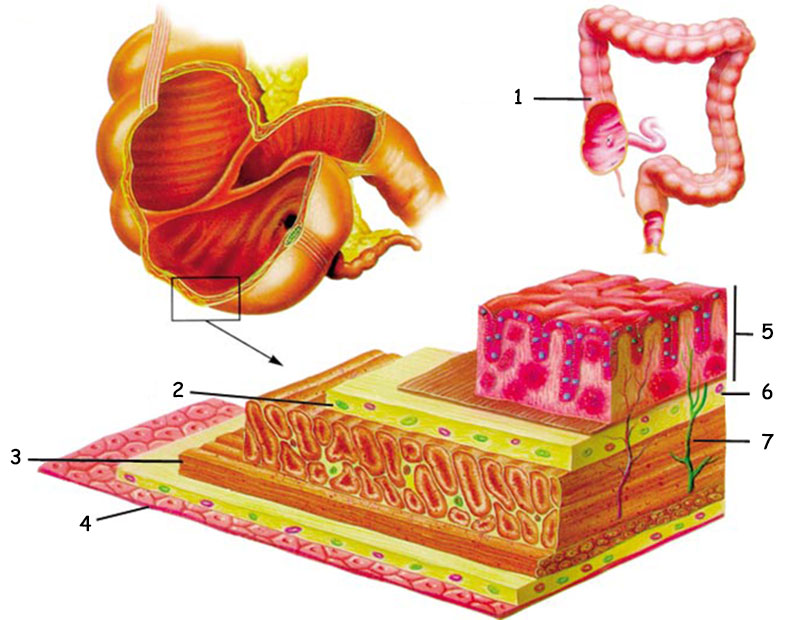 | |
1. Large intestine | 5. Mucosa |
The large intestine, of which various cross-sections are shown above, is responsible for the absorption of Vitamin K, of great importance to the body. | |
This information is most astonishing—and most important. No doubt, it leads us to a Creator Who plans and regulates all. That creator is Allah, Who has planned everything down to the finest detail. Like all living things on Earth, human beings stand in need of Him; they were brought into being and exist by His will. Allah Himself has no need of anything. In one verse it is revealed that:
Say: “Can any of your partner-deities guide to the truth?” Say: “Allah guides to the truth. Who has more right to be followed—He Who guides to the truth, or he who cannot guide unless he is guided? What is the matter with you? How do you reach your judgment?” (Surah Yunus: 35)